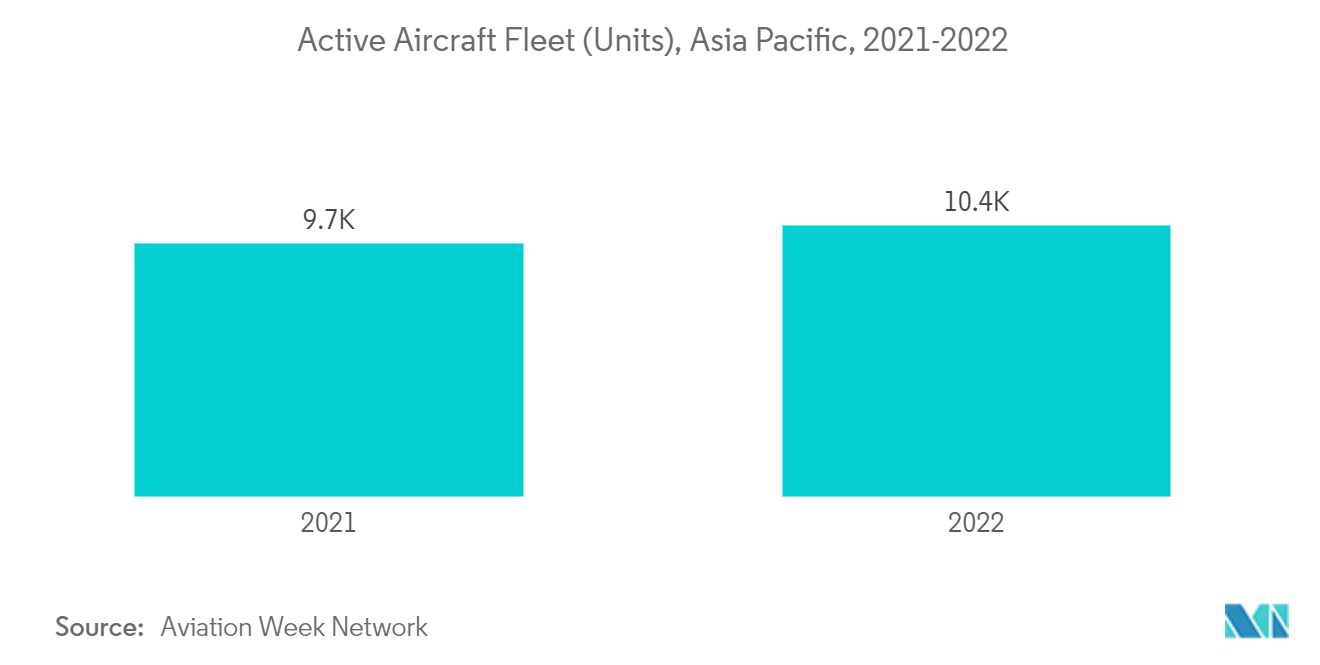Market Trends of Asia Pacific Commercial Aircraft Aerostructures Industry
Composites Segment is Estimated to Show Significant Growth During the Forecast Period
- Asia Pacific has shown the highest growth in the number of air travelers in recent years, driven by increased spending on the aviation sector and a rising number of passengers, particularly in India and China. According to the International Air Transport Association (IATA), Asia-Pacific airlines experienced a 464.8 percent increase in September 2022 compared to the same period last year, the strongest year-over-year growth rate among all regions.
- Passenger capacity also rose by 165 percent in 2022. In addition, there were 633 known projects at existing airports globally in 2022, with a total investment of USD 565.7 billion. Of these projects, Asia Pacific is among the largest spenders on airport infrastructure, with 228 ongoing infrastructure projects valued at USD 227 billion. Thus, the growing investment in the aviation sector drives the demand for new commercial aircraft and their components, including composite materials.
- Composite materials are widely used in aerospace applications, including brackets, engine blades, nacelles, interiors, single aisle wings, propellers/rotors, and wide-body wings, due to their lightweight, high strength, and good fatigue resistance. These materials have exceptional strength and stiffness-to-density ratios and superior physical properties. A composite material typically consists of relatively strong, stiff fibers in a tough resin matrix, with carbon fiber, glass, and aramid-reinforced epoxy being the three main types used in aerospace. Composite materials have played a vital role in reducing the weight of aerostructures, accounting for more than 20% of the A380's airframe. Glass-fiber-reinforced and carbon-fiber-reinforced polymers (CFRPs) are used extensively in fuselage sections, wings, doors, and tail surfaces.
- For instance, in July 2021, Markforged, the creator of the integrated metal and carbon fiber additive manufacturing platform, the Digital Forge, launched two composite materials, Onyx™ FR-A, and Carbon Fiber FR-A, for aerospace and other applications. This demonstrates the growing use of advanced composite materials that provide high stiffness, strength, and reduced weight of aerostructures, thereby driving the growth of the market.

India Will Showcase Remarkable Growth During the Forecast Period
- In the current scenario, India is experiencing a significant surge in aircraft manufacturing, air passenger traffic, and commercial aircraft deliveries. The growth in air passenger traffic, along with government investments and support, as well as the need for aircraft with advanced aerostructures, is expected to propel the market to grow significantly in the coming years.
- As per the data released by the Ministry of Civil Aviation in February 2023, the Indian aviation sector witnessed a total of 6,060 domestic aircraft movements, with 3,026 departing and 3,034 arriving flights, carrying a total of 845,941 domestic passengers. Additionally, there were 947 international aircraft movements, with 515 international flights landing in India and 432 flights departing from India, carrying a total of 162,991 passengers. Furthermore, India's air passenger traffic grew by 47% year-on-year to reach 123.2 million passengers in 2022, indicating a strong recovery from the travel slump witnessed in 2021 and 2020 due to the COVID pandemic.
- Furthermore, there has been significant growth in aircraft deliveries in India over the past few years. Several Indian airline companies are now upgrading or replacing their fleet of old aircraft with new and advanced models.
- For instance, in February 2023, Air India announced its plans to purchase a record number of passenger airplanes to compete for a greater share of the booming domestic and international air travel market. The order includes 190 B737 MAX jets, 20 Boeing B787 Dreamliners, and ten widebody B777X planes, for a total of 220 aircraft. Additionally, Air India is ordering 250 airplanes from European manufacturer Airbus, including 210 A320 Neo narrow-body planes and 40 A350 wide-body aircraft.
- Similar initiatives to foster the aviation manufacturing industry in India are expected to have a positive impact on the commercial aircraft aerostructures market in the country during the forecast period.


